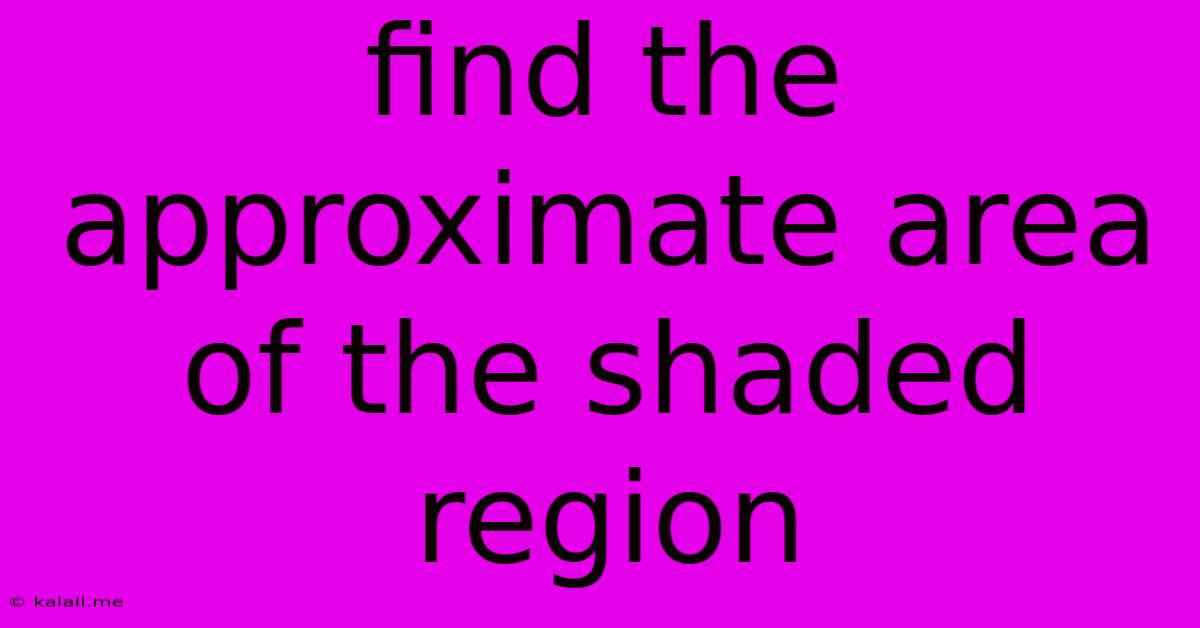Find The Approximate Area Of The Shaded Region
Kalali
Jun 15, 2025 · 3 min read

Table of Contents
Find the Approximate Area of the Shaded Region: A Comprehensive Guide
Finding the approximate area of a shaded region in a diagram is a common problem in geometry and mathematics. This guide will walk you through various methods and strategies, equipping you with the skills to tackle such problems effectively. Understanding different shapes, their area formulas, and approximation techniques is crucial for accurate results. This article covers common scenarios and provides practical examples to help you master this skill.
Understanding the Problem: Before diving into methods, let's clarify what we mean by "approximate area." Unless the shaded region is a simple, regular shape (like a square or circle), calculating its exact area often involves complex calculus. Approximation involves using simpler shapes to estimate the area, accepting a small margin of error. The accuracy of your approximation depends on the method used and the complexity of the shaded region.
Methods for Approximating Shaded Area
Several methods can be employed depending on the shape of the shaded region and the information provided. Here are some common approaches:
1. Using Simple Shapes:
-
Rectangles and Squares: If the shaded region resembles a rectangle or square, measure the length and width (or side length) and apply the formula: Area = length × width (or side × side). This is the simplest approach, yielding a rough estimate.
-
Triangles: For triangular-shaped shaded regions, use the formula: Area = (1/2) × base × height. Measure the base and height as accurately as possible.
-
Circles: If the shaded area is circular or part of a circle (sector), use the appropriate formula: Area = πr² (for the entire circle) or Area = (θ/360) × πr² (for a sector with angle θ).
2. Combining Simple Shapes:
Often, the shaded region can be approximated by breaking it down into several simpler shapes (rectangles, triangles, etc.). Calculate the area of each individual shape and then sum the areas to get an approximate total. This method offers greater accuracy than using a single simple shape. For example, a complex irregular shape might be approximated using several rectangles or triangles that almost fill the shaded region.
3. Using Grids:
Overlay a grid (a square or rectangular grid) onto the diagram. Count the number of complete squares within the shaded region. Estimate the area of partially covered squares by averaging. Multiply the total count (complete plus partial estimations) by the area of one grid square to get an approximation of the total shaded area. This method's accuracy depends on the grid's resolution – finer grids provide better accuracy.
4. Integration (Advanced):
For irregular shapes that cannot be easily decomposed into simple shapes, integral calculus is the most accurate method. However, this requires a good understanding of calculus and the equation describing the shape's boundary. This method is beyond the scope of this introductory guide.
Example: Approximating a Shaded Region
Let's consider a shaded region within a rectangle. The rectangle has dimensions 10cm x 8cm. The shaded area is irregular but roughly resembles a triangle. We can approximate its area as follows:
-
Estimate the triangle's base and height: Let's estimate the base as 6cm and the height as 5cm (visual estimation based on the diagram).
-
Calculate the triangle's area: Area = (1/2) × base × height = (1/2) × 6cm × 5cm = 15cm².
This is an approximate area. The actual area may be slightly larger or smaller, depending on the accuracy of our estimations. Using a grid method would offer a more precise approximation.
Conclusion:
Approximating the area of a shaded region is a skill that requires careful observation, estimation, and the application of appropriate geometrical formulas. The choice of method depends on the complexity of the shape and the desired level of accuracy. Remember to always clearly state your assumptions and methods used when presenting your approximation. Practice with various shapes and methods to hone your skills in solving these types of problems.
Latest Posts
Latest Posts
-
Relationship Between Mass And Acceleration And Force
Jun 15, 2025
-
The Asteroid Belt Is Located Between Which Two Planets
Jun 15, 2025
-
1st Indian To Climb Mount Everest
Jun 15, 2025
-
Which Of The Following Is Not Used As An Antiseptic
Jun 15, 2025
-
Carbon Shows A Very Strong Tendency To Form
Jun 15, 2025
Related Post
Thank you for visiting our website which covers about Find The Approximate Area Of The Shaded Region . We hope the information provided has been useful to you. Feel free to contact us if you have any questions or need further assistance. See you next time and don't miss to bookmark.